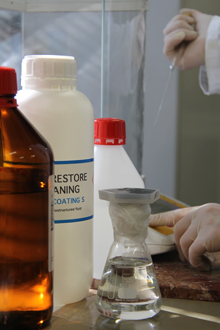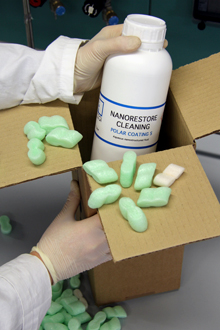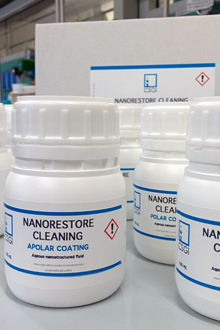

 |
 |
 |
| Nanorestore Cleaning® Polar Coating S |
Water-based nanostructured fluid containing an anionic surfactant and a mixture of 1-pentanol, ethyl acetate and propylene carbonate. This formulation is designed for the removal of polar coatings, such as acrylic and vinyl synthetic polymers and (aged) natural and synthetic varnishes. | 60 €/L |
| Nanorestore Cleaning® Polar Coating B |
Water-based nanostructured fluid containing an alcohol ethoxylate nonionic surfactant and a mixture of methyl ethyl ketone (MEK) and 2-butanol. This formulation is designed for the removal of polar coatings, such as acrylic and vinyl synthetic polymers and (aged) natural and synthetic varnishes. This formulation can be safely used when the presence of salts is significant. | 60 €/L |
| Nanorestore Cleaning® Polar Coating G |
Water-based nanostructured fluid containing an alcohol ethoxylate nonionic surfactant and a mixture of methyl ethyl ketone (MEK), 2-butanol, ethyl acetate, and propylene carbonate. This formulation is designed for the removal of a wide range of polymeric coatings and (aged) natural and synthetic varnishes. This formulation can be safely used when the presence of salts is significant. | 75 €/L |
| Nanorestore Cleaning® Apolar Coating |
Oil-in-water microemulsion containing an anionic surfactant and a mixture of 1-pentanol and xylene. This formulation is designed for the removal of mildly polar synthetic and natural polymeric coatings. | 60 €/L |
| Nanorestore Cleaning® Test Kit |
This kit includes 100 ml of each of the Nanorestore Cleaning® series formulations. It could be used for preliminary tests, in order to choose the best formulation for your specific need. | 50 € |